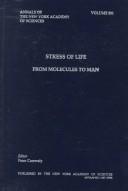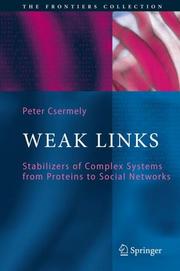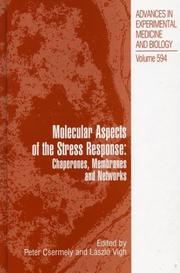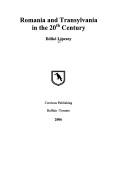| Listing 1 - 10 of 13 | << page >> |
Sort by
|

ISBN: 1573311170 1573311162 Year: 1998 Publisher: New York (N.Y.) : New York academy of sciences,
Abstract | Keywords | Export | Availability | Bookmark
 Loading...
Loading...Choose an application
- Reference Manager
- EndNote
- RefWorks (Direct export to RefWorks)
Physiology: reproduction & development. Ages of life --- Stress (Physiology) --- Congresses. --- -57.04 --- Congresses --- Factors. Influences. Internal, external factors. Physical, chemical factors. Stress --- Conferences - Meetings --- 57.04 Factors. Influences. Internal, external factors. Physical, chemical factors. Stress --- 57.04

ISBN: 3642011926 3540311513 1280627085 3540311572 9786610627080 9783642011924 Year: 2009 Publisher: New York: Springer,
Abstract | Keywords | Export | Availability | Bookmark
 Loading...
Loading...Choose an application
- Reference Manager
- EndNote
- RefWorks (Direct export to RefWorks)
How can our societies be stabilized in a crisis? Why can we enjoy and understand Shakespeare? Why are fruitflies uniform? How do omnivorous eating habits aid our survival? What makes the Mona Lisa’s smile beautiful? How do women keep our social structures intact? – Could there possibly be a single answer to all these questions? This book shows that the statement: "weak links stabilize complex systems" provides the key to understanding each of these intriguing puzzles, and many others too. The author (recipient of several distinguished science communication prizes) uses weak (low affinity, low probability) interactions as a thread to introduce a vast variety of networks from proteins to economics and ecosystems. Many people, from Nobel Laureates to high school students have helped to make the book understandable to all interested readers. This unique book and the ideas it develops will have a significant impact on many, seemingly diverse, fields of study. A very personal, engaging, and unique book that will appeal to readers and get them thinking Steve Strogatz An adventurous, entertainingly eclectic and rich work both for experts and laymen László-Albert Barabási This masterpiece should serve as an example of how science can be discussed György Buzsáki Outstanding - I wish more books were written this way Daniel J. Bilar.
Whole and parts (Philosophy) --- Force and energy. --- Stability. --- Conservation of energy --- Correlation of forces --- Physics. --- Proteomics. --- Biophysics. --- Biological physics. --- Statistical physics. --- Dynamical systems. --- Popular works. --- Nature. --- Environment. --- Geoecology. --- Environmental geology. --- Statistical Physics, Dynamical Systems and Complexity. --- Popular Science in Nature and Environment. --- Biophysics and Biological Physics. --- Popular Science, general. --- Geoecology/Natural Processes. --- Energy --- Physics --- Dynamics --- Mechanics --- Motion --- Vibration --- Benjamin-Feir instability --- Equilibrium --- Ganzheit (Philosophy) --- Mereology --- Totality (Philosophy) --- Unity (Philosophy) --- Wholeness --- Categories (Philosophy) --- Life sciences. --- Science (General). --- Ecology. --- Complex Systems. --- Biological and Medical Physics, Biophysics. --- Molecular biology --- Proteins --- Biosciences --- Sciences, Life --- Science --- Balance of nature --- Biology --- Bionomics --- Ecological processes --- Ecological science --- Ecological sciences --- Environment --- Environmental biology --- Oecology --- Environmental sciences --- Population biology --- Ecology --- Geoecology --- Environmental protection --- Physical geology --- Biological physics --- Medical sciences --- Dynamical systems --- Kinetics --- Mathematics --- Mechanics, Analytic --- Force and energy --- Statics --- Mathematical statistics --- Statistical methods --- System Analysis --- Stability --- Complex organizations --- Social networks
Digital
ISBN: 9783540311577 Year: 2009 Publisher: Berlin, Heidelberg Springer-Verlag Berlin Heidelberg
Abstract | Keywords | Export | Availability | Bookmark
 Loading...
Loading...Choose an application
- Reference Manager
- EndNote
- RefWorks (Direct export to RefWorks)
Science --- Genetics --- General biophysics --- General ecology and biosociology --- Environmental protection. Environmental technology --- Computer science --- sociale ecologie --- biofysica --- popularisering wetenschap --- proteomics --- informatica --- ecologie --- wetenschappen --- proteïnen

ISBN: 1280970057 9786610970056 0387399755 0387399747 1441922970 Year: 2007 Publisher: New York, N.Y. : Austin, Tex. : Sprinter Science+Business Media, LLC ; Landes Bioscience/Eurekah.com,
Abstract | Keywords | Export | Availability | Bookmark
 Loading...
Loading...Choose an application
- Reference Manager
- EndNote
- RefWorks (Direct export to RefWorks)
We are extremely happy to present the reader this book containing a summary of a well-known research field, the phenomenon of cellular stress defense from two new angles: networks and membranes. The volume starts with an introduction to the concept of molecular chaperones in their original sense: R. John Ellis, the founder of the chaperone concept describes chaperones as mediators of correct assembly and/or misassembly of other macromolecular complexes. This sets the tone of the book, where later chapters give detailed examples of the richness of chaperone ac tion by hundreds of other proteins and membrane structures. The reader will learn the role of chaperone classes such as Hsp27 or Hsp90, the action of highly organized chaperone networks in various cellular compartments such as the ER or mitochondrial/ER networks as well as the molecular details of the signaling mechanisms leading to chaperone induction during stress. Various special stress defense mechanisms against oxidative stress or dryness will also be covered. Membranes comprise a surprising mixture of stability and dynamics in the cell. Their role in the regulation of the stress response has been accepted only slowly in the field. Two chapters summarize this important aspect of the stress response showing the importance of membrane hyperstructures, lipid species composition, protein/ membrane interactions and cold adaptation.
Stress (Physiology) --- Molecular chaperones. --- Protein folding. --- Heat shock proteins. --- Stress proteins --- Proteins --- Folding of proteins --- Chaperone proteins --- Chaperones, Molecular --- Chaperonins --- Physiological stress --- Tension (Physiology) --- Adaptation (Biology) --- Folding --- Conformation --- Biochemistry. --- Cytology. --- Immunology. --- Biochemistry, general. --- Cell Biology. --- Biological and Medical Physics, Biophysics. --- Immunobiology --- Life sciences --- Serology --- Cell biology --- Cellular biology --- Biology --- Cells --- Cytologists --- Biological chemistry --- Chemical composition of organisms --- Organisms --- Physiological chemistry --- Chemistry --- Medical sciences --- Composition --- Cell biology. --- Biophysics. --- Biological physics. --- Biological physics --- Physics
Digital
ISBN: 9780387399751 Year: 2007 Publisher: New York, NY Landes Bioscience and Springer Science+Business Media, LLC
Abstract | Keywords | Export | Availability | Bookmark
 Loading...
Loading...Choose an application
- Reference Manager
- EndNote
- RefWorks (Direct export to RefWorks)
Histology. Cytology --- General biochemistry --- General biophysics --- Immunology. Immunopathology --- immunologie --- biofysica --- biochemie --- cytologie --- histologie --- moleculaire biologie
Book
ISBN: 9783540311577 Year: 2009 Publisher: Berlin Heidelberg Springer Berlin Heidelberg
Abstract | Keywords | Export | Availability | Bookmark
 Loading...
Loading...Choose an application
- Reference Manager
- EndNote
- RefWorks (Direct export to RefWorks)
How can our societies be stabilized in a crisis? Why can we enjoy and understand Shakespeare? Why are fruitflies uniform? How do omnivorous eating habits aid our survival? What makes the Mona Lisa's smile beautiful? How do women keep our social structures intact? - Could there possibly be a single answer to all these questions? This book shows that the statement: "weak links stabilize complex systems" provides the key to understanding each of these intriguing puzzles, and many others too. The author (recipient of several distinguished science communication prizes) uses weak (low affinity, low probability) interactions as a thread to introduce a vast variety of networks from proteins to economics and ecosystems. Many people, from Nobel Laureates to high-school students have helped to make the book understandable to all interested readers. This unique book and the ideas it develops will have a significant impact on many, seemingly diverse, fields of study. A very personal, engaging, and unique book that will appeal to readers and get them thinking Steve Strogatz An adventurous, entertainingly eclectic and rich work both for experts and laymen László-Albert Barabási This masterpiece should serve as an example of how science can be discussed György Buzsáki Outstanding - I wish more books were written this way Daniel J. Bilar
Science --- Genetics --- General biophysics --- General ecology and biosociology --- Environmental protection. Environmental technology --- Computer science --- sociale ecologie --- biofysica --- popularisering wetenschap --- proteomics --- informatica --- ecologie --- wetenschappen --- proteïnen

ISBN: 9780387399744 9780387399751 Year: 2007 Publisher: New York NY Springer New York
Abstract | Keywords | Export | Availability | Bookmark
 Loading...
Loading...Choose an application
- Reference Manager
- EndNote
- RefWorks (Direct export to RefWorks)
We are extremely happy to present the reader this book containing a summary of a well-known research field, the phenomenon of cellular stress defense from two new angles: networks and membranes. The volume starts with an introduction to the concept of molecular chaperones in their original sense: R. John Ellis, the founder of the chaperone concept describes chaperones as mediators of correct assembly and/or misassembly of other macromolecular complexes. This sets the tone of the book, where later chapters give detailed examples of the richness of chaperone ac tion by hundreds of other proteins and membrane structures. The reader will learn the role of chaperone classes such as Hsp27 or Hsp90, the action of highly organized chaperone networks in various cellular compartments such as the ER or mitochondrial/ER networks as well as the molecular details of the signaling mechanisms leading to chaperone induction during stress. Various special stress defense mechanisms against oxidative stress or dryness will also be covered. Membranes comprise a surprising mixture of stability and dynamics in the cell. Their role in the regulation of the stress response has been accepted only slowly in the field. Two chapters summarize this important aspect of the stress response showing the importance of membrane hyperstructures, lipid species composition, protein/ membrane interactions and cold adaptation.
Book
Abstract | Keywords | Export | Availability | Bookmark
 Loading...
Loading...Choose an application
- Reference Manager
- EndNote
- RefWorks (Direct export to RefWorks)


ISBN: 1882785150 1882785169 Year: 2006 Publisher: Buffalo Corvinus
Abstract | Keywords | Export | Availability | Bookmark
 Loading...
Loading...Choose an application
- Reference Manager
- EndNote
- RefWorks (Direct export to RefWorks)

ISBN: 1586033085 Year: 2003 Publisher: Amsterdam ; Berlin ; Oxford Brussels IOS Press NATO. Scientific Affairs Division
Abstract | Keywords | Export | Availability | Bookmark
 Loading...
Loading...Choose an application
- Reference Manager
- EndNote
- RefWorks (Direct export to RefWorks)
| Listing 1 - 10 of 13 | << page >> |
Sort by
|

 Search
Search Feedback
Feedback About UniCat
About UniCat  Help
Help News
News